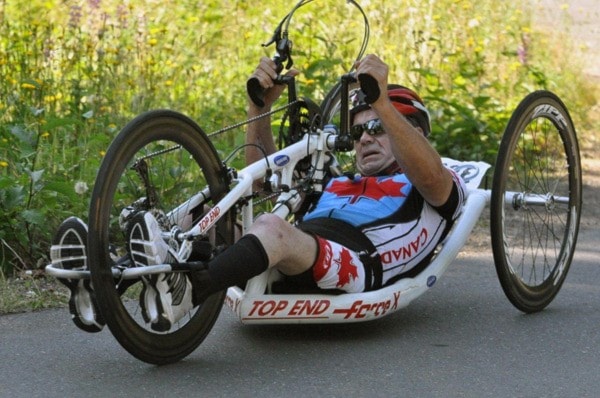Scott Stanfield
Record Staff
He pedals with his hands but that doesn't stop Simon Harrington from competing with — and sometimes beating — able-bodied competitors at cycling events.
Like the recent Dove Creek Omnium hosted by the Comox Valley Cycle Club, where the Courtenay para-cyclist won the criterium and tied for second overall in the C division.
Harrington, 46, used to be a downhill ski racer on the B.C. team for para-alpine, at which time he cross-trained with a hand cycle. A few years ago he became intrigued with the local cycling club when he came across a sign that said Bike Race in Progress.
He started racing in summer time trial events, progressing to mass start races.
"They were really welcoming," Harrington said of club members, noting a bit of apprehension to the hand cycle at the beginning.
When he first raced in category C he would get dropped early on, but lately Harrington has been able to keep up with and even surpass able-bodied cyclists due to his increased strength and better equipment.
"At the first races I would start off at the back — I pretty much do that now anyway — but then I work my way up to the front lately."
The Scotland-born Harrington grew up in Winnipeg and moved to the West Coast at about age 20. When he was 23 he broke his back downhill skiing in Whistler.
He has been on Vancouver Island about 14 years, the first half in Victoria before moving to the Valley.
Harrington competes in the H3 paraplegic category. Last year, he was ranked about 17th in his division by the International Cycling Union by season's end. He has not been ranked this year, likely due to confusion with a race in Montreal.
He kicked off the season in February with a road race in Melbourne, Fla. — the Top End PVA Euro American Handcycle Championship — America's largest hand cycle event that drew 80 competitors. Harrington finished 15th out of 60 men. Then at the Redlands Bicycle Classic in California he placed third overall in points in H3.
He later competed at the Défi sportif in Montreal, from where he qualified for the national development team for his first World Cup para-cycle race in Baie-Comeau, Que.
"It was a great learning experience for me," Harrington said of the World Cup. "As far as placing-wise I didn't do well because basically I'm racing against the best guys in the world. I'm just not quite at that calibre yet, and I had some wrong equipment that didn't help me."
The previous week he had tackled a tougher course at the Canadian road championships in Quebec. Despite taking the wrong wheels, Harrington placed about eighth.
"In reality I was second in my class. They have this kind of odd factoring," he said, noting a woman beat him in the rankings even though her time trial was 10 minutes slower.
Harrington had hoped to compete for Canada at the London Paralympics. His name appeared on the long list but Mark Ledo, an H3 racer from Ontario, was named to the 13-person Canadian para-cycling team.
"He's a very strong athlete," Harrington said.
Para-cycling incorporates a variety of bikes due to the variety of disabilities amongst competitors. Those with a lower limb disability use hand cycles while athletes missing a limb use regular bikes. The latter are classified from C 1-5 while hand cyclists are H 1-4.
H4 competitors hand cycle from a kneeling position. H1 cyclists are quadriplegic and H2 riders are higher-level paraplegics. Like H3, both assume a horizontal position.
Visually impaired cyclists pedal from the back of a tandem bike with a pilot at the front. Athletes with balance issues due to cerebral palsy or head injuries ride on upright, three-wheel trikes.
"The classifications are there for the different types of disability, the type of function or lack of function," said Harrington, who competed this week in Reno, Nev.
"It's a growing sport. That's one of the reasons why I like being out with the Comox Valley Cycle Club. Me being present at races, people see me and they become aware. Maybe there's people out there with disabilities that are going to see there's someone out racing with regular folk and having a great time...We're trying to build the sport, the para-cycling, within B.C."
In years to come he hopes to see a greater number of people involved in the sport, still integrated with able-bodied cyclists but with a sufficient number of competitors to form a para-cycling division at a local event.
"That's what would work great, but right now there isn't the numbers," Harrington said. "So I'm forced basically to race with the able bodies. I want to race so this is a means for me to race. And it's great training for me."
reporter@comoxvalleyrecord.com
